Nicola Moss was born in 1960 in the town of High Wycombe. Her love affair with sculpture dates back to her first three years of life when her mother let her play with a bracelet of gem intaglios and polish her pennies.
More content soon!
| birth | 1960 in High Wycombe |  |
|---|---|---|
| parents | Vanda Burnett Gibson and Derek William Moss | |
| education |
Summer Workshop : Intaglio Glass Engraving, with Peter Driesler (1978) Design Induction Course (1978-79) Foundation in Art and Design (1979-80) Hertfordshire College of Art and Design, St.Albans (1980-83) International Medallic Workshop, Penn. State University (1984) Art And Ecology. Schumacher College, Dartington Devon (2005) | |
| awards |
Scholarship, International Medallic Workshop, Penn. State University (1984) Royal College of Art residency (1988-1989) Gilroy Roberts Scholarship (1994) Northern Arts Small Assistance Award (1996) Northern Print Studio Award, North Shields (1996) J. Sanford Saltus Award (1996) | |
| website | nicolamossartmedals.com | |
| nicolamoss@hotmail.com |
Nicola Moss was born in 1960 in the town of High Wycombe. Her love affair with sculpture dates back to her first three years of life when her mother let her play with a bracelet of gem intaglios and polish her pennies.
More content soon!
You can click on the medals to see the reverse.
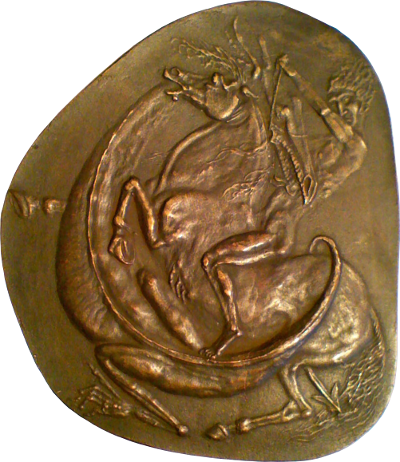
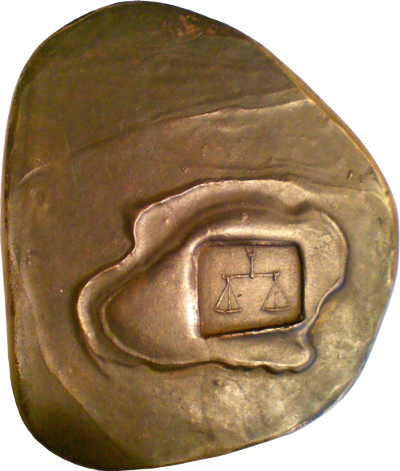
This cast bronze medal reworks the ancient legend of George and the Maiden. The old story tells of the inhabitants of Silene, who were forced to regularly feed a maiden to a dragon that had made its lair nearby. When it was the princess' turn to be sacrificed, George went to rescue her from this tragic fate.
In a feminist treatment of the subject, relevant to the context of the 1980s, Moss shows George absorbed in his fight with the dragon, while the maiden, tired of waiting, decides to rescue herself. No longer the submissive woman of the traditional readings of the story, she cuts her hair to draw strength and establish her independence.
This medal exists in two different versions. The medal depicted here and the medal at the Victoria and Albert Museum differ in the imagery on the reverse.
A copy of this medal can be found at the Victoria and Albert Museum.
The medal measures 101.6mm x 120.6mm.
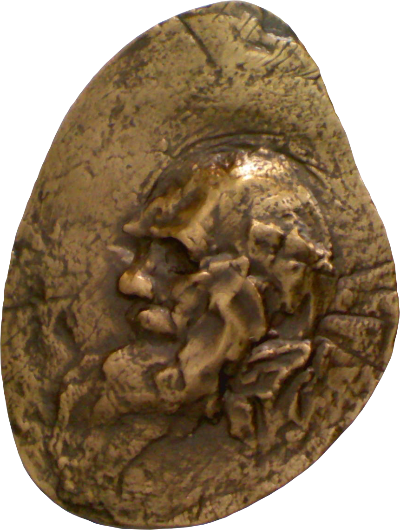
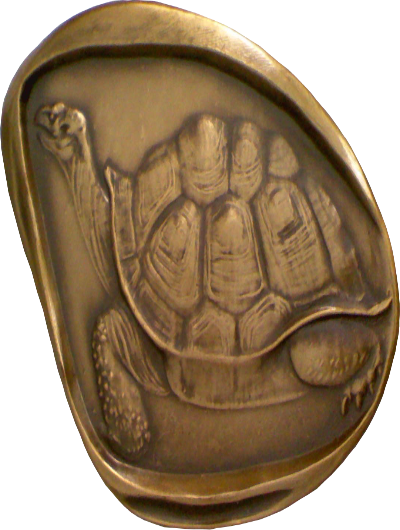
Charles Darwin was the 119th issue in the prestigious Society of Medalists series. Moss was the first non-American sculptor to be admitted into the ranks of Society of Medalists medalists.
According to Moss, the creation of this medal began in 1982 and was inspired by the anniversary of Charles Darwin's voyage aboard HMS Beagle. Moss first crafted the Darwin portrait in clay with "an earthy fossil-like character, and then when I made a cast in plaster the relief took on a bony quality." She was fascinated by the Giant Tortoise and its relation to Darwin. Moss wanted her medal to portray the strength in both man and beast. The result was a bold contrast between a crude and unfinished-looking portrait and a polished tortoise on finished field.
The medal measures 55mm x 73mm and was produced by the Medallic Art Company of Danbury, Connecticut. The edition was limited to 2,500 pieces but the actual mintage is unknown.

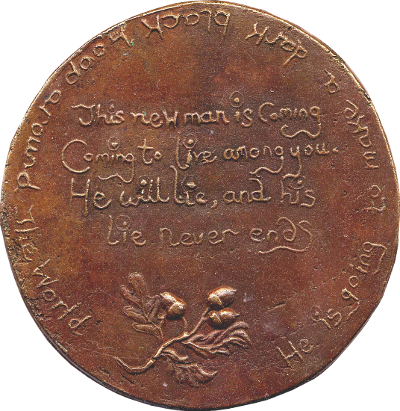
Moss made this medal for the ANS competition in 1991. According to Lakota mythology, the trickster-spider Iktomi gave the following oracle: "This new man is coming, coming to live among you. He will lie, and his lie never ends. He is going to make a dark black hoop around the world."
The artist stresses that this medal should not be interpreted as anti-American but rather as a comment on attributes of modern society. While frequently associated with America, these attributes are by no means exclusive to it. She particularly worries about comsumerism, pollution, and media that "at their worst, have debilitated us with fear, numbed our senses and turned many into wasted, addicted couch potato voyeurs of horror."
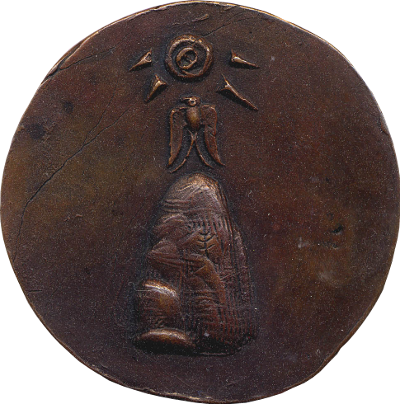
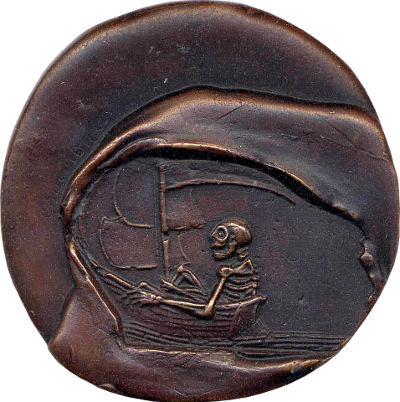
Moss also made this medal for the ANS competition in 1991. She included many elements from the earlier "Dark black hoop around the world" medal in this design but gave them more prominence. While the earlier medal was just a design, this medal was cast and one copy of it is in a European Museum collection (further research needed).

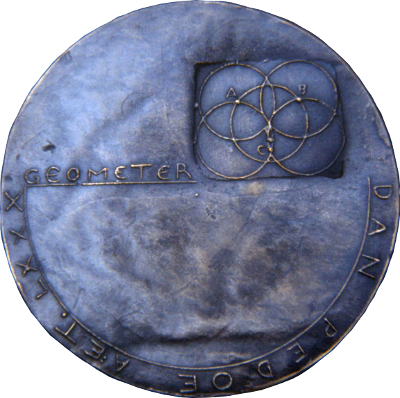
This is a commissioned medal from the artist's time in the U.S.
Moss met Dan Pedoe in 1991 while looking after an artists collective exhibition at the 310 Gallery in Minneapolis. He took interest in her medals and commissioned this portrait medal with a geometric pattern that created a triangle which he and his student had created. He had a lovely collection of Renoir etchings which he was also keen to include as his Muse. As you read the lettering in a straight line and then turn the medal, your eyes are tracing a line and curve of geometry.

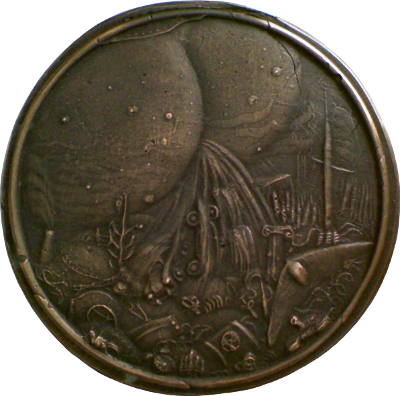
The obverse of Wasichu shows a bespectacled and tie-wearing monster, almost totally reduced to its gaping maw, swallowing nature in all its forms. The reverse depicts an industrialized wasteland with the discarded trappings of our modern life. Immense buttocks that loom over the landscape discharge a fecal stream of waste that rains down from above and threatens to cover everything.
This medal reflects Moss' growing concern about pollution and the consequences of our industrialized way of life.


Turtle Island was commissioned by the Minnesota University College of Architecture and Landscape Architecture. The medal is in the form of a Turtle as in the original creation myth told to Moss by Joe Geshick Ojibwe, an artist and pipe carrier who became a spiritual teacher to her while she stayed in Minneapolis.
The shell is divided into the four quarters by the four directions and at the centre is the primal sacred sweat lodge. About the centre is the landscape bellow, divided by the Mississippi river. Above is the sky divided into day and night. On the under belly Moss used a "dream" symbol that represents two complementary forms either side of a rising or up held light. This may be read as an inner founding seed or idea of male, female and golden child.
In he artists own words:
"I use the word dream a lot to describe an image that came to my inner eye and my attitude to these dreams is that they are sacred gifts that I receive for appropriate use.
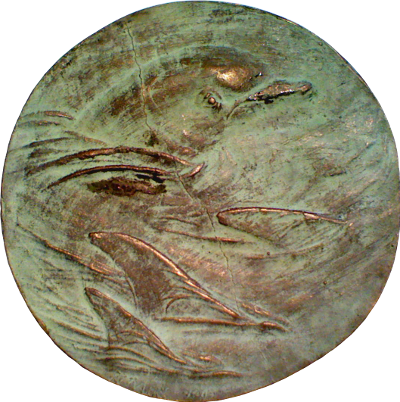
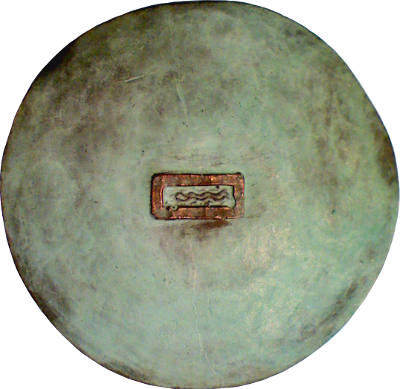
In the artist's own words:
"This medal was conceived and made in New Zealand as a protest medal like wasichu. Having visited Kaikoura
and watched wild dolphins playfully, racing and leaping in the sea, it shocked me to find a sorrowful dolphin
pool on the beach at Napier. The contrast of the two states of being was like life and living death.
This makes me think that we also do this to ourselves: we put ourselves in boxes all the time even our
telepathic abilities are caged by submission to synthetically channelled movie experiences. I am not saying TV
is wrong it follows the story telling tradition but it separates us from real company, and distracts us from
our own creativity. We do not seem to realize that telepathic abilities are innate and that they have been
stolen from us by our dumbed down culture of denial. Why are we so afraid to live subtly, kindly and sensitively?
It is not a weakness to be sensitive it is where our true to life power (love) flourishes, in a sea of sensations
and perceptions all connected all one. We have put up too many barriers boxes and fences to separate us from a
natural life."
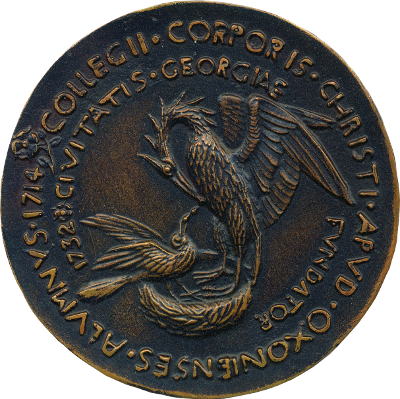
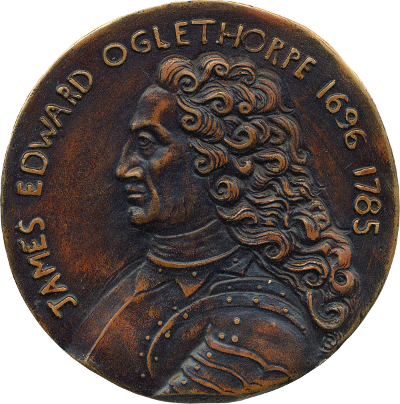
James Edward Oglethorpe (22 December 1696 - 30 June 1785) was founder of the colony of Georgia, born in Surrey England and was at Corpus Christi College Oxford.
The Oglethorpe medal was a medal commissioned in 1996 by an American medal collector on the artist's return to Britain. She is unsure of what happened to this edition. It was sent to America, she was paid and she never heard any more about it. As far as she knows it is now an unknown medal, though an edition of 100 were cast.
In Moss' own words:
"I enjoyed making this medal, playing with Georgia's state bird, the Brown Thrasher, a bird similar to the British Thrush being fed by the Corpus Christi College Oxford symbol of the pelican feeding its offspring with the blood from its heart, as in the Vittorino da Feltre medal by Pisanello. Maybe the medals were not understood as playful but seen as strangely out of date..."
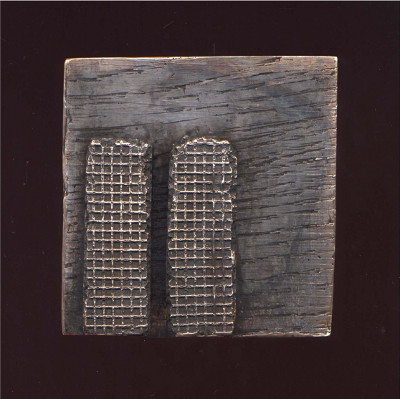
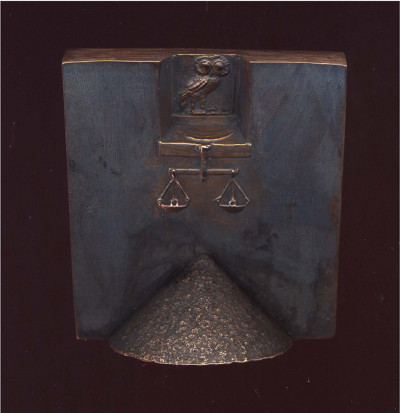
The obverse bears two wafer-like towers on a wood-grained background. The reverse shows a conical pile of ashes at the bottom with a scale and Athena's owl above.
With this medal, the artist tackles a defining moment in modern history: the attacks of September 11th, 2001. She does it in an abstract and thought-provoking way. The towers representing the World Trade Center before the attacks do not look whole and flawless. The pile of ashes to which they have been reduced on the reverse is dominated by scales and Athena's owl. Maybe an appeal to wisdom and justice in the aftermath of the barbaric attack?


Mamoo was produced for friends and members of the British Art Medal Society in 2007. "Mamoo" is the name by which the artist and her sister addressed their grandmother. It also is a universal word that children use for friend. The medal is a reflection on and expression of the transforming female or matriarchal spirit that has influenced the artist's life.
The obverse is dominated by a feminine face surrounded by a ripple of water with a pattern of yellow flag iris. The reverse shows many concentric rings like ripples resulting from a drop of water.
Contact me if you have links that might merit inclusion on this page.